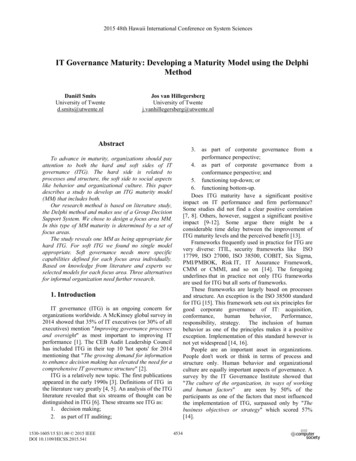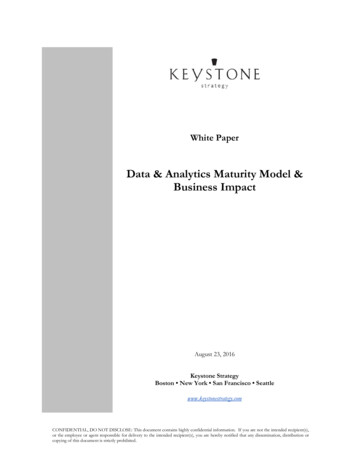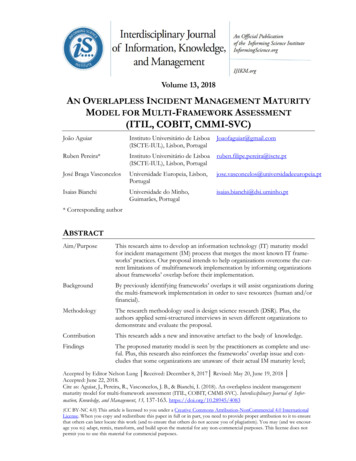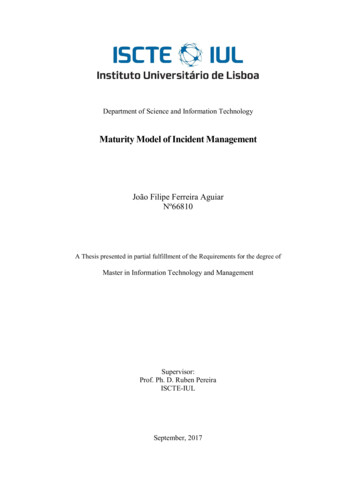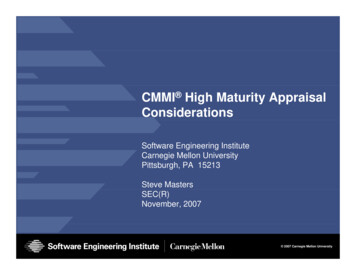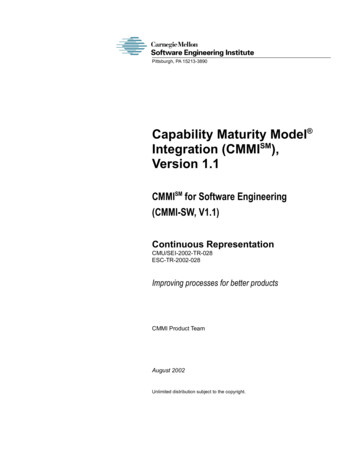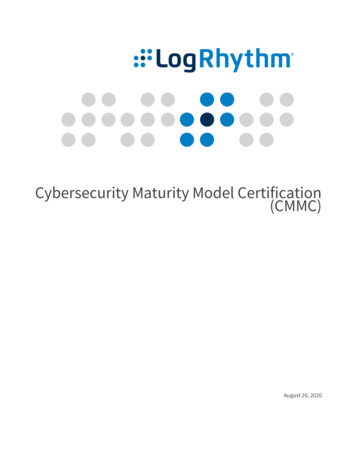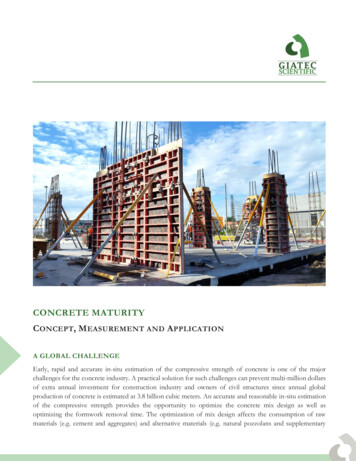
Transcription
CONCRETE MATURITYCONCEPT, M EASUREMENT AND A PPLICATIONA GLOBAL CHALLENGEEarly, rapid and accurate in-situ estimation of the compressive strength of concrete is one of the majorchallenges for the concrete industry. A practical solution for such challenges can prevent multi-million dollarsof extra annual investment for construction industry and owners of civil structures since annual globalproduction of concrete is estimated at 3.8 billion cubic meters. An accurate and reasonable in-situ estimationof the compressive strength provides the opportunity to optimize the concrete mix design as well asoptimizing the formwork removal time. The optimization of mix design affects the consumption of rawmaterials (e.g. cement and aggregates) and alternative materials (e.g. natural pozzolans and supplementary
cementitious materials like fly-ash and silica-fume). Considering the high volume global consumption ofconcrete, this could, in turn, effectively optimize the consumption of resources and reduce a great extent ofCO2 and toxic materials (emitted during the cement production) into the atmosphere.The maturity method is a convenient approach to predict the early age strength gain of concrete, using theprinciple that the concrete strength is directly related to the hydration temperature history of cementitiouspaste. The maturity concept for estimating the strength gain of concrete is described in ASTM C1074,Standard Practice for Estimating Concrete Strength by the Maturity Method. This method can potentiallyaddress many immediate challenges facing the concrete industry such as predicting appropriate time forformwork stripping and post-tensioning, especially at low temperatures while the strength development ofconcrete is hindered; and optimizing concrete mix design and concrete curing conditions (e.g. concrete heatingat low temperatures or surface protection in hot-dry weathers). Lack of an accurate estimation of strength atearly ages of construction is twofold: contractors either wait too long for next action (e.g. stripping formwork)which is costly due to delays in completing the project, or they act prematurely which could cause the concretestructure to crack - that would lead to future durability and performance issues - or even structural collapse.In most construction sites, field-cured concrete samples are tested to strength at various ages during the firstweek since concrete is poured, in order to make a decision on formwork removal. ASTM C873 offers a testmethod for cast-in-place cylindrical specimens. These specimens can be removed later for measuring thecompressive strength of concrete in the lab. Usually, if the concrete reaches 75% of its designed strength, thestructural engineers allow for the striping of forms. The problem, however, is that only one specimen iscrushed for strength estimation. This is not necessarily accurate. This method is limited to use in horizontaland thick concrete elements like slabs. In addition, the construction crew is usually on the job site while theyare waiting to hear about the compressive strength result from the lab. This adds to the cost of constructionand its uncertainty decreases the efficiency of the construction. Although alternative methods such as concretematurity exist, there is a traditional resistance to utilizing them for most concrete projects. Except for specificprojects, the concrete industry shows interest in the commonly used compressive strength test. This is mainlydue to the upfront cost of concrete mixture calibration for maturity curves, and lack of expertise for theinstallation of concrete temperature sensors, data collection and analysis.Such approaches to compressive strength evaluation may cause concrete contractors to make conservativedecisions, face more complicated technical problem (e.g. delay in formwork stripping, and unnecessary longterm curing and surface protection), and spend more financial resources.As a non-destructive testing, the maturity method may be a reasonable candidate to fill this gap. In comparisonto most on-site non-destructive technologies (e.g. Schmidt Hammer or Ultrasonic Pulse Velocity), theprivilege that the maturity method stands on is that, the procedure for estimating the compressive strengthwould be objective and qualitative once the maturity curve is developed and adopted.This technical article describes how the maturity curve is developed, and how it is applied for on-siteestimation of the compressive strength of concrete.
WHAT IS THE PRINCIPLE OF THE MATURITY METHOD?Maturity method is a relatively simple approach for estimating the in-place compressive strength of concrete,specifically at early ages less than 14 days. Once the maturity curve is developed in the laboratory for a specificproject, it can be used for on-site estimation of compressive strength of concrete in real-time.The maturity method is governed by the fundamental assumption that a given concrete mix design pouredduring course of a specific project has the same compressive strength when it has the same “maturity index”.It means that a given concrete mix design, for example, may reach the same compressive strength after 7 daysof curing at 10 C when it is cured at 25 C for 3 days.The maturity method based on the ASTM C1074 is the most commonly used method to estimate the in-situstrength of concrete. ASTM C1074 provides two maturity functions: 1) Nurse-Saul function; and 2) Arrheniusfunction. Based on the Nurse-Saul method, there is a linear relationship between the maturity and thetemperature in real time. The underlying assumption is that the strength development in concrete is a linearfunction of hydration temperature. Equation 1 shows the relationship between maturity and hydrationtemperature history.𝑀(𝑡) (𝑇𝑎 𝑇0 ). 𝑡𝐸𝑞. 1Where: M(t) is the maturity index at age t; Ta is the average temperature during time interval t; T0 is thedatum temperature. ASTM C1074 provides a standard procedure to find the datum temperature for a specificmix design. However, most of previous studies suggest a practical estimation of the datum temperature thatis between 0 C and -10 C. Indeed, this is the temperature at which the hydration of cementitious paste stops;hence the strength development of concrete ceases. Unpublished results by Giatec Scientific Inc. show thatthis temperature resides within an interval between 0 C and -5 C dependent on the concrete mix design.The second approach is the Arrhenius function that assumes there is an exponential relationship between thecompressive strength and hydration temperature. The maturity index is defined in form of an equivalent ageat a reference temperature. It means the actual age should be normalized to the reference temperature in orderto estimate the compressive strength. This function needs a value of activation energy that can be determinedas the procedure detailed in ASTM C1074.Despite the fact that the Arrhenius function is scientifically more accurate, the Nurse-Saul function is morecommonly used by concrete industry because of the following reasons:1. The accuracy of the Nurse-Saul function is adequate for most field applications;2. The Nurse-Saul function is relatively simpler compared with the Arrhenius function.HOW IS THE MATURITY – STRENGTH CURVE DEVELOPED VIA THE NURSESAUL FUNCTION?As detailed in ASMT C1074, there is a step-by-step guide for developing the maturity curve, and for estimatingthe compressive strength. These steps are described as follows.
The maturity-strength curve represents the relationship between maturity index and compressive strength fora specific concrete mix design, adopted in the laboratory. To do so, adequate concrete cylindrical specimensshould be casted, and then stored in the semi-adiabatic condition for curing. Certain number of concretecylinders (i.e. at least two concrete specimens) should be equipped by embedded temperature sensors forrecording the hydration temperature history. The compressive strength of concrete is measured at ages of 1,3, 7, 14 and 28 days.The maturity index is calculated at strength testing times using Equation 1. Then the best curve will be fittedfor the strength data versus maturity index data. The following chart schematically shows which actions arerequired to build the maturity-strength curve. It should be noted that it is important to test the concrete mixdesign that will be the same as that used in the construction project. Any deviations from the original mixdesign (such as water to cement ratio, cement content, etc.) will reduce the accuracy of the maturity methodto estimate the compressive strength.
Once the maturity – strength curve is developed, it can be used to estimate the in-place concrete strengthusing the hydration temperature history. To do so, the temperature history of the concrete elements shouldbe recorded after pouring using embedded sensors at the locations that are generally critical in term ofexposure conditions, curing and structural requirement. Routine quality control tests should be performed toensure the accuracy of the maturity – strength curve. These controls minimize any error in the estimation ofin-place strength due to inherent limitations of the maturity method.Some of important limitations are listed as follows: In-place concrete is not representative of the concrete used to develop the calibration in the lab.This can be because of changes in materials, water to cement ration, air content, batching method,etc;In-place concrete is not properly placed, consolidated, cured, etc;Very high early-age temperatures can lead to inaccurate estimation of strength at later ages;Using a datum temperature (for the Nurse-Saul function) that is not representative of the concretemixture can result in incorrect estimation of strength.
Several maturity devices have been developed that can measure the hydration temperature of concrete in realtime. Most of these devices such as Flir Intellirock, Command Center, and Concure iDrop can calculatematurity index and predict the compressive strength if the maturity – strength curve, datum temperature andany required information are developed. Most of these devices include a temperature sensor embedded intothe concrete elements that is plugged in the data logger via an electrical cable. Alternatively, a simplethermocouple could be embedded in concrete for temperature monitoring using a connected data logger. Thedata should then be extracted and used to calculate the maturing index and use it to estimate the concretestrength from the maturity curve.
Giatec Scientific Inc.301 Moodie Dr., Suite 302Ottawa, Ontario, K2H 9C4CanadaTel: 1 (613) 240-7451Fax: 1 (613) 280-1544http://www.giatec.ca
ASTM C1074 provides a standard procedure to find the datum temperature for a specific mix design. However, most of previous studies suggest a practical estimation of the datum temperature that is between 0 C and -10 C. Indeed, this is the temperature at which the hydration of cementitious paste stops; hence the strength development of concrete ceases. Unpublished results by Giatec .
